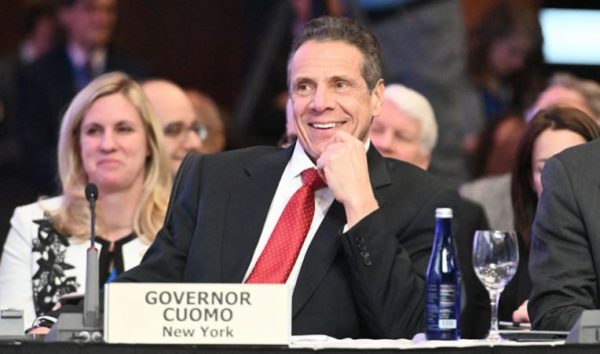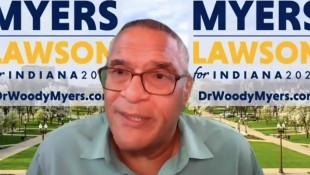Office of Governor Andrew M. Cuomo
Governor Cuomo at the National Governors Association Conference in February.
The governor has not had a lot to show for his White House meetings with the president.
February 14, 2020
This willingness to deal with a president deeply unpopular among Democrats was hardly surprising, given Cuomo’s identity as a pragmatist. The governor has a long track record of crafting deals with Democrats and Republicans alike on tricky issues including congestion pricing, the minimum wage and gay marriage.
But he has not had a lot of luck in his negotiations with President Trump. In fact, it may be that Cuomo’s brand of politics are irrelevant or ineffective when dealing with a narcissist who thrives on division and offers up empty promises. The president has left the governor hanging after White House meetings on taxes, infrastructure and – it now appears – a move by the Trump Administration that makes New Yorkers ineligible for a program the Department of Homeland Security’s Trusted Traveler programs.
This latest controversy began last week when DHS announced that it was rejecting New Yorkers’ applications into programs that make it easier to pass through airport security or immigration checkpoints, because the federal government could not access a state database for drivers’ licenses since a new law went into effect late last year that allows undocumented New Yorkers to get drivers’ licenses. Creating bureaucratic barriers to block federal immigration officials from using the personal information they gave to the state was important to assuaging concerns about raising the risk of deportation for undocumented immigrations. Not only did the move take the Cuomo administration by surprise, a memo from the department revealed by Buzzfeed found that the change happened in order to punish New York for its immigration-friendly policies. In a statement the next day, Cuomo called the memo “a documented admission by the Trump administration that they are purposely targeting law-abiding U.S. citizens to play partisan politics.”
Cuomo was still willing to hash things out with Trump. After a period of mutual recriminations Cuomo said that he would allow the federal government to access DMV records when it was necessary to screen applicants for Trusted Traveler programs, the reasoning being that undocumented immigrants would not be among them. Cuomo and Trump then agreed to meet at the White House on Feb. 13.
A little over an hour before the meeting was set to begin, a presidential tweet let everyone know what the meeting was really all about – at least from his perspective. “He must understand that National Security far exceeds politics,” Trump wrote. “New York must stop all of its unnecessary lawsuits & harrassment [sic], start cleaning itself up, and lowering taxes. Build relationships, but don’t bring Fredo!” In other words, the president was saying that letting New Yorkers cross the border with relative convenience all depended on Cuomo making state government do a variety of things beyond changing its policies about drivers licenses.
The Fredo remark was another signal that the governor stood no chance of getting Trump to agree to end the impasse. Cuomo said months ago that comparing his brother Chris – or any Italian-American – to an inept character in “The Godfather” was an insulting ethnic slur.
The governor went to the White House nonetheless. That both the Trump and Cuomo administrations described the hour-long meeting as “productive” was itself a minor miracle; many of Trump’s meetings with Senate Minority Leader Chuck Schumer and House Speaker Nancy Pelosi do not go nearly as well. But that does not mean Cuomo wrangled any actual concessions from Trump, or that New Yorkers are any closer to getting their access restored to the Trusted Traveler programs.
To do that, Cuomo would have to play under Trump’s rules, meaning putting on the negotiating table issues like taxes, immigration policies and the state’s various lawsuits against the Trump administration. By putting all of them into one tweet, Trump was offering Cuomo a deal that he could never accept for a variety of reasons. The state has a lot of interests besides Trusted Traveler programs. The political cost to Cuomo among New York Democrats could be immense. Moreover, the governor was being asked to participate in a quid pro quo that, while perhaps legal, shared characteristics, such as Trump using presidential power to extort personal or political favors, with the president’s recent demands that Ukraine investigate former Vice President Joe Biden in exchange for the release of congressionally appropriated U.S. military aid to the Eastern European country.
That’s not to say that Cuomo has no leverage in negotiating with Trump, who seems to desire praise and the appearance of political or personal victory more than substantive policy achievements. The governor could offer some concessions. For example, he could agree to push for changes to the new requirements on drivers licenses and do his best to make state lawmakers go along. Cuomo could agree to drop the lawsuit that the state filed against the administration after the Trusted Traveler freeze went into effect. There is even the possibility that Trump wouldn’t mind getting a high-profile Democratic governor to make a deal with him so soon after his own impeachment trial. But, as of this writing, the governor has nothing tangible to show from their meeting.
This fits in well with Cuomo’s past dealings with Trump. A 2018 meeting on a proposed project to build a rail tunnel under the Hudson River also described as “productive” after the two leaders met at the White House. A spokesman for Schumer told The New York Times at the time Trump “wants to use Gateway as leverage to trade for the wall,” referring to the wall along the U.S.-Mexico border that Trump wants to build. While Cuomo said at the time that the meeting did result in substantive progress, concerns continued into the following year that Trump was just stringing him along. The Trump Administration has continued signalling that it would approve the project, but has yet to sign off on the grants that would make that happen, Politico reported on Feb. 10.
Cuomo had even less luck with convincing Trump to back changes to the new federal tax law that Republicans passed in 2017, which limited the State and Local Tax Deduction. Cuomo has called it an “economic missile” aimed at New York, but he has tried and tried and tried again to find ways to address the change in a way that would help New Yorkers avoid a big effective hike on the taxes they owe to the federal government each year. Trump listened to Cuomo’s concerns, but the SALT deduction is still capped at $10,000 per year.
In Cuomo’s defense, it is not easy for any governor to take on a president. The president has a variety of ways to wield his power at the federal law, from pushing Congress to pass legislation to changing federal rules on a wide range of issues. Trump has only gotten better at this with time. He has become even more politically aggressive since the end of his impeachment trial by firing federal officials who gave damaging testimony against him and other moves that include his freeze of New Yorkers’ applications for the Trusted Traveler programs. While Cuomo has to get Gateway approved by the Trump administration, the wisdom of meeting with him could be proven if the federal government does end up supporting a project that had appeared to be a done deal with New York and New Jersey under the Obama administration. Ditto with efforts to get Trump to help with building an extension of the Second Avenue Subway and implementing congestion pricing, which requires federal approval.
Cuomo acknowledged shortly before the Feb. 13 meeting that trying could be his first step towards failure in getting Trump to reverse the freeze on the Trusted Traveler programs. “You’re asking me if I have a high expectation of success? No,” he told reporters at a New York City press conference. “But it makes me feel better knowing that I did everything I could to argue for the state of New York … that is my role.” Now that the meeting has come and gone, the two leaders will follow up on the issue next week, according to a Cuomo spokeswoman.
Rather than fight Trump on Twitter, as former New York City Mayor Michael Bloomberg does, Cuomo has elected to give negotiation a shot in order to make something happen on an issue that has a big effect on his state, especially considering how international and domestic business travel to and from New York is so crucial to its economy. While some political observers might say that Cuomo was only setting himself up for failure by meeting Trump this week, there was a political benefit to doing so no matter what happens with Trump, according to political consultant Hank Sheinkopf. “It doesn’t matter if he gets anything from Trump or not,” Sheinkopf said. “What matters to the governor is that he appears to be an advocate for the state and his public profile continued to be heightened.
Yet, if this latest round of negotiations with Trump fails to get Cuomo the result he desires, then he might want to heed an old adage about not being fooled by the same trickster more than once. If Cuomo does end up getting what he wants through negotiations with Trump, then the governor’s brand of dealmaking will have proved itself with the most unlikely of negotiating partners – but Cuomo should be prepared for disappointment.


